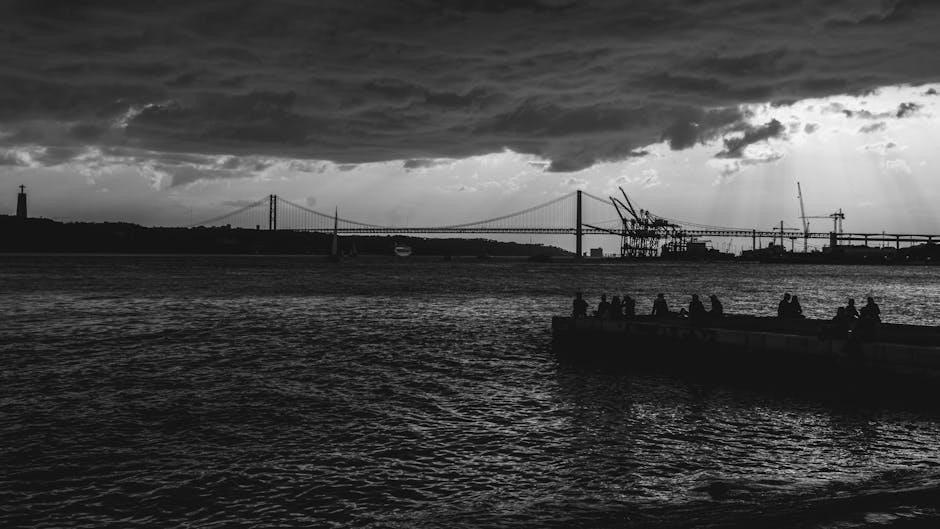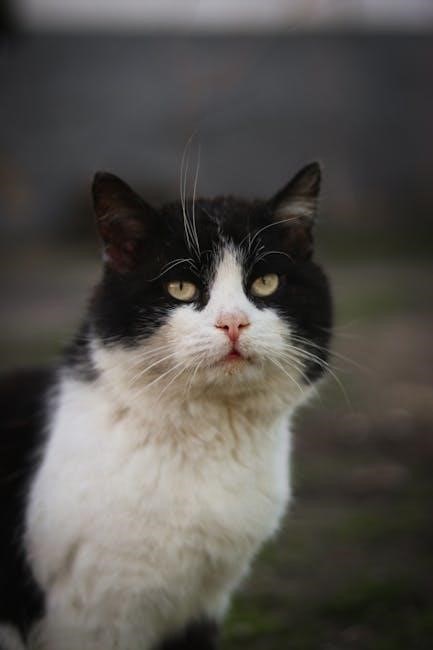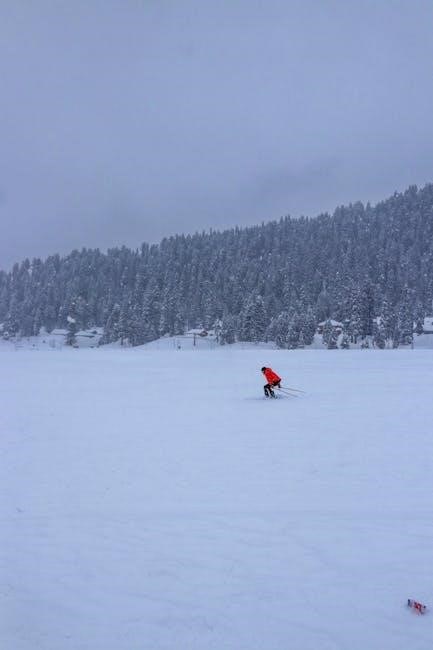The Canon EOS 80D is a versatile DSLR camera designed for both beginners and advanced photographers, offering advanced features like a 45-point AF system and 24.2MP sensor.
1.1 Overview of the Canon EOS 80D
The Canon EOS 80D is a high-performance DSLR camera designed for enthusiasts and professionals. It features a 24.2MP APS-C CMOS sensor, 45-point all-cross-type AF, and 1080p video recording. Known for its durability and ergonomic design, the 80D is ideal for capturing stunning images in various conditions, making it a popular choice among photographers seeking quality and reliability.
1.2 Key Features and Specifications
The Canon EOS 80D boasts a 24.2MP APS-C CMOS sensor, 45-point all-cross-type AF, and 7 fps continuous shooting. It records 1080p video at 60 fps and offers a 3-inch LCD touchscreen. ISO ranges from 100-16000, expandable to 25600. Wi-Fi and NFC enable seamless connectivity. Dual SD card slots and weather-sealing enhance versatility, making it a robust choice for photographers seeking advanced functionality and performance in various shooting scenarios.
Understanding the Camera Layout
Familiarizing yourself with the Canon EOS 80D’s layout is essential for effective use. External controls and buttons are strategically placed for quick access, while the menu system offers customization options to streamline your shooting experience.
2.1 External Controls and Buttons
The Canon EOS 80D features an intuitive layout with external controls and buttons designed for quick access to essential functions. The mode dial on top allows easy switching between shooting modes, while buttons for ISO, autofocus, and white balance are conveniently placed for rapid adjustments. The multi-controller and quick control dial simplify menu navigation and settings adjustment. The shutter button and AF-ON button provide precise control over focusing and image capture. Understanding these controls enhances your shooting efficiency and customization capabilities.
2.2 Menu Navigation and Customization
The Canon EOS 80D offers a user-friendly menu system with customizable options to tailor the camera to your preferences. The menu is divided into tabs for shooting, playback, and setup, allowing easy access to settings like image quality, autofocus, and metering modes. Users can also create a custom menu by adding frequently used settings to the “My Menu” tab for quick access. This feature enhances workflow efficiency and personalizes the shooting experience, ensuring quick adjustments and streamlined navigation.
Mode Dial Options
The Canon EOS 80D features a mode dial with options like Auto, P, Tv, Av, M, and custom modes (C1, C2, C3), offering flexibility for various shooting scenarios.
3.1 Understanding Different Shooting Modes
The Canon EOS 80D offers various shooting modes, including Auto, Program (P), Shutter Priority (Tv), Aperture Priority (Av), Manual (M), and Custom modes (C1-C3). These modes cater to different photography needs, from point-and-shoot simplicity to advanced creative control. Auto mode is ideal for beginners, while Manual mode provides full control over exposure settings. Custom modes allow users to save personalized settings for quick access, enhancing workflow efficiency and consistency in various shooting scenarios.
3;2 Customizing Modes for Personal Preference
The Canon EOS 80D allows users to customize shooting modes to suit their preferences. For instance, you can register frequently used settings to the Custom Modes (C1, C2, C3) on the Mode Dial. This feature is ideal for streamlining workflows, especially in familiar shooting environments. By saving settings like aperture, shutter speed, ISO, and white balance, photographers can quickly recall optimal configurations, enhancing efficiency and consistency in their work.
Autofocus and Metering
The Canon EOS 80D features a 45-point autofocus system and advanced metering modes for precise focus and exposure control, ensuring sharp images and accurate light capture.
4.1 Using Autofocus Effectively
To use autofocus effectively on the Canon EOS 80D, leverage its 45-point AF system by selecting the right mode—One-Shot for stationary subjects or AI Servo for moving ones. Use the AF-ON button for back-button focusing, ensuring sharper images. Experiment with different AF point selection modes, like Single Point or Zone AF, to track subjects precisely. Customize AF settings in the menu for faster focus acquisition and improved accuracy.
4.2 Understanding Metering Modes
The Canon EOS 80D offers four metering modes: Evaluative, Center-Weighted, Partial, and Spot. Evaluative metering analyzes the entire scene for balanced exposure. Center-Weighted prioritizes the center area, ideal for portraits. Partial metering focuses on a small central area, while Spot metering measures light from a specific point. Each mode helps achieve accurate exposures by tailoring light measurement to the scene, ensuring optimal results in various lighting conditions.

Exposure and White Balance
The Canon EOS 80D allows precise control over exposure using aperture, shutter speed, and ISO. White balance settings ensure accurate colors in various lighting conditions, with options like Daylight, Shade, Tungsten, and custom presets for tailored results.
5.1 Mastering the Exposure Triangle
The exposure triangle—aperture, shutter speed, and ISO—is fundamental for controlling light in photography. Aperture regulates depth of field, shutter speed captures motion, and ISO adjusts sensitivity. Balancing these elements ensures optimal exposure. On the Canon EOS 80D, these settings can be manually adjusted using the control dial and quick control dial for precise creative control. The camera also offers Auto ISO for convenience in changing lighting conditions.
5.2 Adjusting White Balance for Accurate Colors
White balance ensures accurate color representation by compensating for lighting conditions. The Canon EOS 80D offers presets like Auto, Daylight, and Tungsten, plus custom options. Use the WB button or menu to adjust settings. Custom white balance allows precise calibration using a reference object. Accurate white balance enhances image quality and reduces post-processing corrections, ensuring natural colors in various lighting scenarios.

Image Quality and File Formats
The Canon EOS 80D delivers high-resolution images with adjustable compression. Choose between JPEG for convenience or RAW for detailed post-processing flexibility, optimizing storage and workflow needs.
6.1 Choosing the Right File Format (JPEG vs. RAW)
The Canon EOS 80D offers two primary file formats: JPEG and RAW. JPEG provides compressed, ready-to-use images with smaller file sizes, ideal for sharing and everyday use. RAW files, however, capture uncompressed data, offering greater flexibility in post-processing for professional editing. Understanding the differences helps optimize storage and workflow, ensuring the best results for your photography needs.
6.2 Setting Image Quality and Compression
Setting image quality and compression on the Canon EOS 80D involves selecting options like “Large,” “Medium,” or “Small” for JPEG files, which adjust resolution and file size. Compression reduces file size by eliminating redundant data, preserving quality. RAW files are uncompressed, offering maximum detail for editing. Adjusting these settings optimizes storage and image detail, suiting different photography needs effectively.

Flash and External Lighting
The Canon EOS 80D features a built-in flash and supports external Speedlites, enhancing creativity and expanding lighting possibilities for photographers.
7.1 Using the Built-in Flash
The Canon EOS 80D’s built-in flash provides convenient lighting for low-light situations. It offers a guide number of 12m at ISO 100 and supports manual power adjustment. The flash can be activated via the camera’s menu or external button, offering red-eye reduction and slow-sync modes for balanced exposures.
7.2 Working with External Speedlites
The Canon EOS 80D is compatible with external Speedlites, offering advanced lighting control. Use the Speedlite Transmitter ST-E3-RT for wireless flash setups or connect Speedlites via the hot shoe. External flashes provide greater power and flexibility, enabling creative lighting techniques. Adjust flash power manually or use E-TTL III for precise exposures. This integration enhances your photography with professional-grade lighting options.

Video Recording and Live View
The Canon EOS 80D supports Full HD video recording at 60fps, enabling smooth motion capture. Live View mode allows precise composition on the LCD screen, with touch focus for quick adjustments.
8.1 Shooting Video with the Canon EOS 80D
The Canon EOS 80D excels in video recording, capturing Full HD at 60fps with sharp details. Movie Servo AF ensures smooth focus tracking, while manual controls allow adjustment of aperture, shutter speed, and ISO for cinematic effects. The camera supports MP4 and MOV formats, and its vari-angle touchscreen simplifies framing. Built-in Wi-Fi and NFC enable easy file transfer, making it ideal for vloggers and content creators.
8.2 Using Live View for Still Photography
Live View on the Canon EOS 80D enhances still photography by allowing precise focus control and real-time preview of settings. The vari-angle touchscreen enables shooting from unique angles, while Touch AF simplifies focusing. Grid display and aspect ratio options help in composition. Additionally, Live View supports face detection and tracking, ensuring sharp portraits. This feature is particularly useful for macro, product, and studio photography, offering greater creative control.
Customizing the Camera
Customize the Canon EOS 80D to suit your preferences by adjusting settings, creating custom menus, and personalizing shooting profiles for enhanced functionality and streamlined workflows.
9.1 Customizing Buttons and Controls
The Canon EOS 80D allows users to customize buttons and controls for enhanced convenience and efficiency. Assign functions like AF-On, AE Lock, or ISO to buttons like the M-Fn or Depth of Field Preview buttons. The Multi-controller can also be customized for AF point selection or menu navigation. This feature ensures quick access to frequently used settings, streamlining your workflow during shoots.
9.2 Creating Custom Shooting Profiles
The Canon EOS 80D allows users to create up to three custom shooting profiles, enabling quick access to preferred settings. These profiles store configurations like shooting mode, AF settings, and white balance. This feature is ideal for photographers who frequently switch between different shooting scenarios, such as portraits, landscapes, or sports. Custom profiles enhance efficiency and ensure consistent results across various photography genres.
Troubleshooting and Maintenance
Regular maintenance ensures optimal performance. Clean the sensor, check firmware updates, and inspect lenses for damage. Address common issues like error codes or improper autofocus quickly for best results.
10.1 Common Issues and Solutions
Common issues with the Canon EOS 80D include error codes like “Err 01,” which indicate communication problems between the camera and lens. Clean the lens contacts or replace the lens. Autofocus malfunctions can be resolved by recalibrating or updating firmware. Sensor cleaning is essential to avoid dust spots. Regularly check for firmware updates to ensure optimal performance and resolve bugs promptly for smooth operation.
10.2 Cleaning and Maintaining the Camera
Regularly clean the Canon EOS 80D to maintain performance. Use a soft cloth to wipe the exterior and a microfiber cloth for the lens. For the sensor, use a blower or cleaning swabs. Avoid harsh chemicals and never touch the sensor surface. Store the camera in a dry, cool place to prevent moisture damage. Check for firmware updates to ensure optimal functionality and address potential issues promptly.
